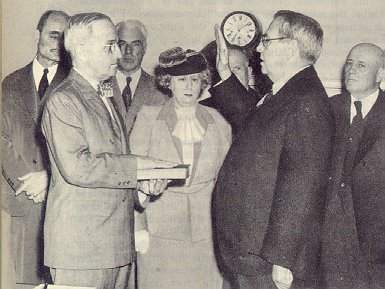War prosecuted in earnest
By 1940, it seemed that the Japanese might turn southward toward the oil, tin and rubber of British Malaya and the Netherlands Indies. In July 1941, when the Vichy government permitted the Japanese to occupy the remainder of Indo-China, the United States froze Japanese assets. On November 19, after General Tojo's government had taken office in Japan, a special envoy, Saburo Kurusu, arrived in the United States. Kurusu announced that the purpose of his mission was to arrive at a peaceful understanding, and on December 6, President Roosevelt sent a personal appeal for peace to the Japanese Emperor. On the morning of December 7 came the Japanese answer-a shower of bombs on the American base at Pearl Harbor.
 |
| Vice-President Harry Truman takes the oath of office as President of the United States at the sudden death of Franklin Roosevelt in 1945. Three years later, he was elected President in his own right. |
The onset of war came to the American people as a great philosophical defeat. They had never liked or accepted militarism, and so far as it was possible, the Constitution of the United States placed the stamp of civilian control upon American life. Thus, in America the war was everywhere looked upon as a grim and unfortunate but necessary turn in the nation's history. No American could think of the war as having any goal other than lasting peace. On December 9, when President Roosevelt delivered his war message to the American people, he reminded them: "The true goal we seek is far above and beyond the ugly field of battle. When we resort to force, as now we must, we are determined that this force should be directed towards ultimate good as well as against immediate evil. We Americans are not destroyerswe are builders."
The nation rapidly geared itself for an effort that called for the mobilization of its manpower and its entire industrial capacity. On January 6, 1942, President Roosevelt announced production goals which in ordinary times would have staggered the nation. He called for delivery in that year of 60,000 planes, 45,000 tanks, 20,000 anti-aircraft guns, and 18,000,000 deadweight tons of merchant shipping. All the nation's activities-farming, manufacturing, mining, trade, labor, investment, communications, even education and cultural undertakings-were in some fashion brought under new and enlarged controls. Money was raised in enormous sums; great new industries were created; striking new techniques were developed, as in the mass production of ships and planes; major shifts in population took place. Under a series of conscription acts, the armed forces of the United States were brought up to a total of 15,100,000. By the end of 1943, approximately 65,000,000 men and women were either in uniform or in essential occupations.
Soon after the United States was drawn into the war, it was decided that the essential military effort of the Western Allies was to be concentrated in Europe where the core of enemy power lay. In the meantime, the Pacific theater of war was to be secondary. Nevertheless, during the dark year, 1942, some of the first important American successes came out of actions in the Pacific. These were primarily accomplishments of the navy and its carrier-borne aircraft. In May 1942, heavy Japanese losses in the battle of the the battle of the Coral Sea forced the Japanese navy to give up the idea of striking at Australia; in June, carrier planes inflicted severe damage on a Japanese flotilla off Midway Island; in August came a unified army-navy action which resulted in an American landing on Guadalcanal and another naval victory,the battle of the Bismarck Sea. The hope of further victories was increased as the navy began to swell with incredible rapidity as a result of intensified shipyard production.
